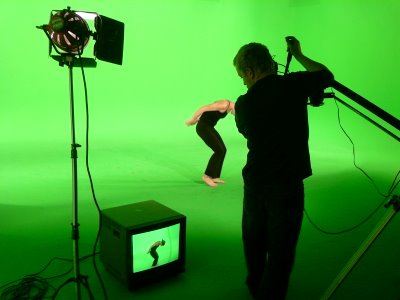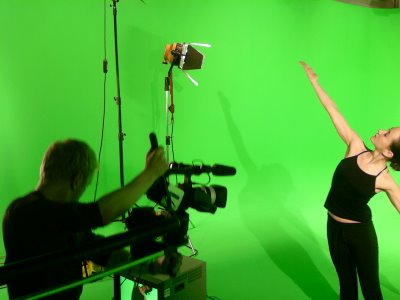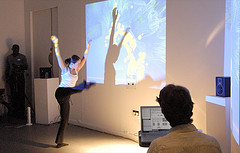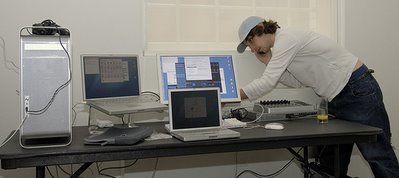Tuesday, December 26, 2006
What frameworks and technologies for inter-disciplinary performance facilitate collaborations between art forms?
Inter-disciplinarity draws insights from and integrates two or more disciplines. - Wikipedia
Foundations
This essay starts by considering what are the meanings that we give to 'inter-disciplinary' performances. It investigates how they facilitate open-ended collaboration among art forms. It concentrates specifically on the ways in which network technologies bring together dance, music and video. It draws on Latour's accounts of frames, which situate signs in terms of time, space and actants: ... [constructions which] are animate, inanimate or even abstract entities ...' (Williams, R. 1992, paraphrasing Latour 1988). Signs may involve description (to write down, creating a trace), inscription (to make a text), subscription (to support another frame, text, trace), conscription (to mobilise a frame, sign, text, trace in performance), transcription (to write across and thus to rework or transform a frame, text, trace in performance). Frames may take many forms. My concern is with the ways in which sets of performances, involving music, dance, art and video are framed by and frame one another.
My initial project is to consider examples of how inter-disciplinary performances have worked within and across these frames - and the signs, texts and traces which they situate. My second is to examine the contingent dialogues that may take place within and across the frames, in which the movement of each defines the movement of one or many others. The study will examine the possibilities and limits of specific technologies that have been used and which might be developed to create new kinds of performance.
In my own practice, with a focus on interactive video, I work with people from different disciplines, both 'artistic' and 'technical'. This led me to work with Jonathan Green to develop Collaborative On-line Distributive Art (CODA). This study will look at the opportunities this systems enables, the work I have created with it, and my own use of it. CODA can create networked environments where dance, music, art, video and data streams can interpolate over local or global networks.
Performances typically use a call and response frame to situate actants. Dancers, musicians, actors respond to one another and audiences whether these are improvised or set in time and space. The recording and play back of dance is not the same as live performance. Video, like film, is produced according to its own language and technologies. Live, non-linear and interactive editing and manipulation systems allow video to collaborate in live performances. The editior or 'VJ' can now edit/ perform live in reponse to dancers and musicians.
Network systems that allow interpolated data streams between video, music and dance create new possibilities. The performance space is constructed from multiple feeds of sound, image, movement and architecture. My own work concerns itself with presence within an architectural space. The human element is the live control and response to the constructed environments. It creates resonances, tensions and disruptions among all these elements. Networked systems allow us a fluidity among sets of frames. Does this create space for emergant forms of expression?
Examples
To explore the themes and constructs I have identified I need to set my own work against that of several differrent practitioners. The examples I have chosen identify different ways of combining artitic performances and network technologies.
An example of the inter-diciplinary work I will consider is the collaboration between John Cage, Merce Cuninngham and others, specifically in their 1960's work, Variations V. The dancers perform in a space constructed by movement which generates and triggers sound. These are then filtered and reconstructed by the audio artists. Mixed television images and film are projected on to screens around the space but are themselves unaffected by the performers other than their physical placement. Cunningham's recent productions use the Lifeforms software to choreograph virtual performers the movement of which is then transposed onto live dancers. The video instillation 'Ghostcatching' uses virtual dancers transposed from motion captured of human dancers. (Cunningham and Jones, 2004)
I will investigate Matt Gough's critical work on hyper choreography. My interest lies in his theories of the possibilities for audiences to create and alter perceptions of work by creating ' ... a networked environment where all links are revealed and 'new' links can added by users, multi directional - two way connection enhance the perception of intertexts. No longer must the author use chance procedures to disrupt their unconscious constructions of meaning, the provision of a mechanism to explore, expand and visualise the intertexts of their authored text performs the same function.' (Gough)
Michael Takeo Magruder by contrast uses algorithmic programming to take live feeds from the internet. 'Each article is deconstructed into its basic image and text components. This material is then algorithmically recombined into an aesthetic entity in which the informational content is still partially discernible.' (Magruder)
These issues emerge out of and provide instances of wider overlapping traditions of multidisciplinary performance. The final dissertation will be written and submitted as a blog. This allows readers to access hyperlinked references to the text, include video, sound and images embedded within the text. The ability to tag paragraphs enables the reader to reorder and filter the text they want to read. This approach will reflect both the subject matter and method of this essay.
References
Latour, Bruno, "A Relativistic Account of Einstein's Relativity', Social Studies of Science, 1988, Vol. 18, pp. 3-44.
Williams, Roy, "Discourse analysis of social documentaries on television" Ph. D. thesis, University of the Witwatersrand, 1992.
Magruder, Michael Takeo, http://www.takeo.net
Gough, Matt, http://binarybutoh.blogspot.com/
Cunningham, Merce and Bill T. Jones, "The Ghost in the Machine" A Journal of Performance and Art, Vol. 24, No. 1, pp. 94-104. 2004
Bibliography
Gould, Stephen Jay. Wonderful Life : the Burgess Shale and the Nature of History. MIT Press, March 13, 2006
Antin, David. Video: The Distinctive Features of the Medium. Touchstone/ Simon & Schuster, 1967.
Massumi, Brian. A User’s Guide to Capitalism and Schizophrenia : Deviations from Deleuze and Guattari. MIT Press, 1992.
Pressing, J. "Cybernetic issues in interactive performance systems" Journal of Comparative Music, Vol. 14, no. 1, pp. 12-25. 1990
Deleuze, Giles and Guatttari, Felix. Anti-Œdipus. Viking Press ,1972
Deleuze, Giles and Guatttari, Felix .A Thousand Plateaus., 1988
Cunningham, Merce.. A Lifetime of Dance DVD: John Cage and Merce Cunningham, Director: Charles Atlas.
De Spain, K. " Dance and the Camera. Envisioning Dance on Film and Video, (ed. Judy Mitoma, Elizabeth Zimmer, and Dale Ann Stieber). Dance Chronicle Vol. 28, Issue 3, 2005
Roberto Morales-Manzanares, "SICIB: An Interactive Music Composition System Using Body Movements". Computer Music Journal Archive, Volume 25 , Issue 2 (2001) pp. 25 - 36.
Lichty, P. Caught in the Grid: Towards a Digital Minimalism. cited - voyd.com
http://www.artmuseum.net/w2vr/timeline/ - Timeline and discussion of pioneers of network and technology based art work.
http://www.leeds.ac.uk/paci/projectingperformance/home.html -' Projecting Performance', Dance, motion capture and scenography.
http://www.turbulence.org/ - Net art commissioner
http://www.turbulence.org/blog/ networked performance - Networked performance references
http://www.david-o.net/wordpress/ - Interactive dance and network blog
http://binarybutoh.blogspot.com/ - Splines in Space, Matt Gough's dance Blog
http://www.jg1983.co.uk/ - Jonathan Green, Network and music researcher,
http://greatdance.com/danceblog/ - Dance technology Blog.
http://greatdance.com/danceblog/archives/dance_and_technology/000478.php - Spreading Dance with Mashups, March 10, 2006
Saturday, December 23, 2006
Friendly Fire Night
Just a heads up about our night on Jan 12th down at Rooty Frooty,The Custard Factory. Check out the Friendly Fire website for more music and info.
I'm also testing out the a web browser for my mac called Flock. It alows you to blog and pull image feeds into blog within the browser. So far it's seems the quickest method for blooging I've tried. I'd like to find a blog application that allows you to set links that automaticly come up when you write certain words. As you add new links they go into a databases that can be drawn from sort of like a style sheet. I'm sure this has already been done somewhere so if anyone knows what it's called tell me.
technorati tags:Jam, Jah, FriendlyFrie
Monday, December 18, 2006
- What defines the relationships between the performer-dancer, the projected image and the performer-operator?
- What are the methodologies for the engagement of performance academics and digital technologists in effective collaborative research?
What interests me about this project is the week it seeks to explore the relationship between performer and video artist or the 'operator'.
'This project investigates a new set of interrelationships between performer, projection and technical operator, where the operator also becomes a ‘performer’ both controlling and being spontaneously present in the digital image on stage. The stage-performer interacts with the off-stage operator, who simultaneously sees, controls and 'performs' the projected image in the stage 'picture'. The expressive nature of the digital image concentrates the quality of the operator's movement through abstract forms that are choreographed with the stage performer.'
This interaction between performers I feel is fundamental to the creation of collaborative work using technology. This conversation between the stage and the projection needs to become one which utilises the skill of both performers. The human element in controlling and responding live to a another performer is built in to dance but has been lacking due to technological and the methodologies within live video and technological performance.
The video of one of there experiments can be seen HERE
This video got myself and Jonathan Green thinking about ways in which to trace points within a performance space. We discussed using a series of Max/MSP patch's to do this:
- We can start by tracking skin colour of other colours on the dancers body. This can be more than one point at once and can be done by determining RGB levels and/or luminosity.
- These points can then be traced using another patch.
- The resulting points can then be filtered to create multiple images and styles on the stage. This set of filters can be effected by movement sensors on stage as well as by a 'controller'.
- This resulting image can then be placed into another VJ package to edited live and then projected into the performance space.
We have though of a few ways of projecting:
- Onto a semi-transparent screen covering the front of the stage.
- Onto several banners and screens divided around the space.
the great thing is using the CODA system and pre designed Max/MSP patch's we can do this without to much designing or engineering.
Thursday, December 07, 2006
Dissertation outline
This essay will investigate the manner in which multidisciplinary performance facilitates collaboration between art forms. It will concentrate on the use of dance, music, video and network technologies within multidisciplinary art. It will examine and critique the frameworks and facilitation used by artists and choreographers in creating multidisciplinary works and set these against my current work with networked collaboration. It will analyse how these frameworks function and how they can be generated and adapted by the singular art forms that they are made up of. It will subsequently examine how they are presented to the audience.
The essay will:
- Highlight aspects of these frameworks that both facilitate and hinder multidisciplinary work. These issues will also be discussed through examination of other, specific practices in adjacent fields.
- Analyse my own practice within the context of this work, identifying the aspects of my work that address the issues highlighted.
- My current work has led to the creation of networked environment where dancers, musicians, artists and data streams can all work together over a local or global network. The following is an except from my notes on a workshop I did at the Ikon gallery:
Our Gridded technology allows for collaborative performance. The traditional separation and resulting lack of synchronisation between disciplines during performance is abandoned in favour of a modular system, which promotes learning, exploration and experimentation that increases the indeterminacy in the creation and reading of the work.
The Gridded distribution of artists and technical know-how does not, as may be expected, decrease the strength of relationship between disciplines, but rather makes possible a more integrated performance through interdisciplinary communication. The notion of content fusion is a result of the inclusive methodology employed.
Since usability has been a priority in the conception of the system, performers (dancers, VJs and electronic musicians in this case) are liberated from the burden of poor software interfaces and are instead free to concentrate on interpersonal communications and the reactions of other performers.
I will examine several philosophical concepts where relevant. The work of Deleuze & Guarttari on the Rhizome and its relevance particularity to technological network systems. It will also touch on both Brecht and Wagner’s ideas relative to inter-disciplinary, trans-disciplinary and multi-disciplinary practice.
Through studying community driven web 2.0 applications, such as Flickr, Bluedot and YouTube it will examine future possibilities for multidisciplinary works. I can investigate and construct my own collaborative art web 2.0 application based on my current network design.
Tele-Trigger

 Jonathan and myself worked on a project for the last three days using C.O.D.A [Collababorative Online Digital Arts] system to create a piece for a tutorial. The piece is two TV's facing each other with a web cam on each. Each TV has displays the feed form it's webcam. As you aproach each TV an infra-red sensor makes the screen fade to the feed form the web cam behind you. Simple but effective we think. Keir
Jonathan and myself worked on a project for the last three days using C.O.D.A [Collababorative Online Digital Arts] system to create a piece for a tutorial. The piece is two TV's facing each other with a web cam on each. Each TV has displays the feed form it's webcam. As you aproach each TV an infra-red sensor makes the screen fade to the feed form the web cam behind you. Simple but effective we think. Keir
Suzanne Again
Here's a quicky, a new video a did of Suzanne using the same multi-canon thing. However this was done live using Modul8 as I exported the original clip with an alpha channel from FCP. This allows me to experiment and eventually hook up some motion sensors so that the audience can alter the number of dancers, colour etc. by moving in the space. It also means I can experiemtn in real time with no rendering : )
The Planetarium
Myself, Jonathan Green and Steven Davis went to visit the new digital Planetarium at Millennium Point, Birmingham. It's a giant aluminum dome that has a set of six overlapping projectors around the circumference. We watched a demonstration of the system. It consisted of a tour of the stars starting from a British night sky then flew through to a view from the moon. This was done using a wireless PDA and joystick. When we looked at the possibilities for out work we all came up with quite different ideas and concepts. I won't go into these yet but what was very useful for us was the very helpful Mario Di Maggio who runs the planetarium. He showed us the workings of the place. It all runs from a standard xp server running software that we can hack into with C.O.D.A. system myself and Jonathan are working on at the moment. this means we could control aspects of the projection with sensors, phones, dancers, mikes and anything else we can think of. The real challenge of the whole project will be the 3000*3000 resolution needed. This then has to be distorted to allow for the shape of the dome. Anyway further details to come...
Been away what you been at?
Tuesday, November 21, 2006
Mat Gough - Hyperchoreography
The following quote from his blog fits with the work of Cunningham and Cage that I've been looking at in the use of chance within a rigid structure. Also the multi-directional links he describes is what we're trying to create with the tagged data from our system.
"in a networked environment where all links are revealed and 'new' links can added by users, multi directional - two way connection enhance the perception of intertexts. no longer must the author use chance procedures to disrupt their unconscious constructions of meaning, the provision of a mechanism to explore, expand and visualise the intertexts of their authored text performs the same function."
- Mat Gough - networked choreography - ii
Mat Gough says previously to the above quote:
if the initial conditions (the movement corpus) of a dance work are small and ring-fenced (the choreographer produces, selects and controls the material) then our bias for particular semiotic readings results in a low level of indeterminacy. the only way to achieve 'maximum' indeterminacy is for the choreographer to exert minimal control over the movement corpus.
'minimal control' of the corpus need not mean 'found' choreography in the tradition of 4'33", if we define choreography as 'making structures in which movement may occur' then the choreographer can still retain some ownership of contextual meaning. presented in an appropriate structure, divergent content forms the dissonant harmony of authored indeterminacy
I think the next quote fits with the manner in which Cage and Cuningham work in Variations V. The chance element of the dancers position to the antennae and the creation of the score using dice rolls within Variations V is the minimum control within the corpus of the work. This creates an indeterminacy within the work. However they still maintain a 'ring-fenced' approach to the work in the rigidity of the over riding structure of the piece by Cage and Cunnignham. This lowers the level of the indeterminacy by reducing the divergence of the forms within the piece. The framework is static with the chance creating the indeterminacy within the structure creating a 'fabricated' hyperchoreography as the indeterminacy of the mixing forms is limited within this static structure.Rhizome - Deleuze & Guarttari
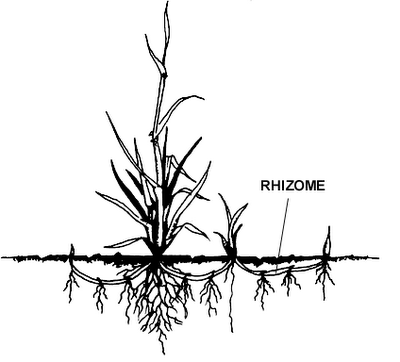 I've been reading a section of Deleuze & Guarttari's essay 'A Thousand Plateaus: Capitalism and Schizophrenia. I was advised by David Cheeseman my MA tutor to look at the theory of the Rhizome as it applies to Jonathan and my work on creating adaptive creative frameworks. I don't want to attach a response to the work yet as I'm still trying to take in the language of the essay which is pretty hard going. Above however I will take out quotes that interest me and I think have a relevance to the work we're creating.
I've been reading a section of Deleuze & Guarttari's essay 'A Thousand Plateaus: Capitalism and Schizophrenia. I was advised by David Cheeseman my MA tutor to look at the theory of the Rhizome as it applies to Jonathan and my work on creating adaptive creative frameworks. I don't want to attach a response to the work yet as I'm still trying to take in the language of the essay which is pretty hard going. Above however I will take out quotes that interest me and I think have a relevance to the work we're creating.The Networked Mash-Up: Gridded Resources in Real-Time
An overview of a demonstration by a VJ (Keir Williams), electronic musician (Jonathan Green) and a dancer, of a computer network designed especially for the performing arts.
Identification of Possibilities of E-Science
Gridded technologies allow for collaborative performances. The traditional separation and resulting lack of synchronisation between disciplines during performance is abandoned in favor of a modular system which promotes learning, exploration and experimentation which often leads to happy accidents.
The gridded distribution of artists and technical know-how does not, as may be expected, decrease the strength of relationship between disciplines, but rather makes possible a more integrated performance through interdisciplinary communication. The notion of content fusion is a result of the inclusive methodology employed.
Since usability has been a priority in the conception of the system, performers (dancers, VJs and electronic musicians in this case) are liberated from the burden of poor software interfaces and are instead free to concentrate on interpersonal communications and the reactions of other performers.
We wanted to use novel and user-friendly hardware interfaces to the complex computer software we needed to use. We chose gamepads, fader boxes, microphones (audio analysis) and motion sensors. We took the idea of interfacing a little further and thanks to an iSight and motion capture software especially designed for the system, we were able to use a dancer literally as a bidirectional computer input device. The dancer provided real-time motion data and at the same time was free to react to the sense of space and the resultant projections. This interactive performance ‘loop’ became evident on several levels.
Conclusion of Possibilities
Through the demonstration we had proved that our concept of the networked mash-up had some promise. Our system allows for synchronisation between different performance disciplines. We even managed to prove the system not only in a local network, but also over the internet (see Remote-Controlled Max Patches post). Our system could be scaled up in terms of number of nodes, collaborators and geographical locations (see Future Possibilities below).
Practicalities of a Distributed Performance System
The system is based on a number of nodes. In our demonstration we had three computer nodes (network devices, in other words). It could be argued that the dancer herself is a node, since she feeds and reacts to other nodes. A node, therefore, does not have to be a computer or a traditional network device.
Some example of possible nodes:
* musical instrument (audio analysis, done at source, provides the control data)
* sensor networks (motion capture and environmental data)
* RSS feeds (the internet as a node)
Our gridded system is open to data generated externally. A real-world example of why this might be absolutely necessary: random numbers. Computers cannot generated entirely random numbers. During our demonstration, we accessed a website which publishes random numbers generated by the beta-decay of Krypton-85.
What is Distributed?
* computing power – we could not have done video analysis, audio synthesis and real-time video processing on a single computer
* data – any computer on the network could contribute data or pull down any data and then transform it in a specialised manner
In contrast, the following is not distributed:
* specialist performer skill of specific disciplines
* function – each node carries out its own specialist function
An important concept here is that each node does not need to know how other nodes function, only what data they produce, and even then, each data packet does not have a sender’s address.
At the moment all data exists in a relatively flat hierarchy (like MIDI). There is no means of filtering out unwanted data according to characteristics, type, source or any other meta data. This would certainly be a limitation if the system were expanded.
Data is broadcast in a sterile format that does not favor any particular discipline. It is up to a particular node to filter the data in a way which is appropriate to the function of that node.
Future Possibilities
As explained above, we are limited by the data protocol. At the moment, we are using MIDI which is non-descriptive. This not only makes it difficult to use, requiring a separate document giving a description of each stream of data, but also limits scalability. By tagging data with meta-data, we solve not only issues of scale but also usability. By using a more human-readable protocol (such as Open Sound Control) we can draw a parallel with existing, proven data filtering systems employed by Flickr, YouTube and del.icio.us.
Conclusion (Social Impact)
The notion of distribution, whether computing power, data, knowledge or responsibility is suggestive of the Open Source paradigm. Open Source projects often have a wide user-base and community of enthusiasts. Collaboration is taken for granted.
If scaled up, the Networked Mash-Up idea could bring together artists from diverse backgrounds and working practices in a non-location specific manner (although the location of nodes could be conceptually exploited).
Resources
* Network schematic screenshot
* E-Science Max Patches (used in demonstration)
* Photos from the E-Science workshops on Flickrr> * Remote-Controlled Max Patches – notes on expanding the system
* Video of performance on YouTube
Saturday, November 18, 2006
Green Screen - Revisited
As I've said Steve runs Film Cafe a production company. He has a large range of equipment which includes a Camera Jib. This jib allows the camera to move freely on all axis including up and down. This allowed me to get shots of Suzanne where the camera could 'dance' in repsonse to her movement. Above are the stills and video I shot on my camera phone. Watch out for the footage of the shoot as the week goes on.
Tuesday, November 14, 2006
Variations V notes
puts forward the idea that John Cage, Merce Cunningham and Robert Rauschenberg, "...placed their stakes not on holistic aspirations but on artistic autonomy and difference." He goes on to say that this is an extension of Bertolt Brecht's argument against the Wagner idea of 'Gesamtkunstwerk' in 'Notes on the Opera (1930):
So long as the expression ‹Gesamtkunstwerk› (or ‹integrated work of art›) means that the integration is a muddle, so long as the arts are supposed to be ‹fused› together, the various elements will all be equally degraded, and each will act as a mere ‹feed› to the rest.… Words, music, and setting must become more independent of one another.4
If we look at the performance Variations V and the framework constructed for it we can see this exemplified. The dancers perform in a media constructed space in that there movement within the performance space generates and triggers sound. This is then filtered and constructed by the audio artists. On the back drops mixed television images and film are projected but unaffected by the performers other than there placement within the physical space. The dance and music score was decided by using a coin to determine the position of each element. The elements consisted of 35 remarks dealing with structure, components and methodology. This randomness combined with a selection of predefined structural elements including the physical space fits into the idea of separation of the art forms whilst contributing to a constructed whole.
The reactive performance space isn't constructed to allow the dancers to have total control of the musical score. It hasn't become a direct instrument in the traditional sense. The music triggered by the dancers is controlled and filtered by the audio artists and the selection of the sounds that form the bases of the electronic score. There is however an element of control for the performers in that they have the feed back from their movement in the form of music, therefor allowing them to repeat actions that generate specific sounds or effects. The sound triggered by the dancers is controlled and filtered by the audio artists and the selection of the sounds that form the bases of the electronic score.
This control of the sound by the performers is an element in the overall control of the music artists and engineers. Equally the dancers movement and expressio is still controlled by the initial movement vocabulary and choreography of Merce Cunnnigham. The elements of chance in the consruction of the score and in the movements relationship to the sound acts as both a connectino between the forms and a disruption. The staginbg of the film and vidoe work has an influence on the other art forms by being part of the pre constructed placement and framework thus becoming part of the physical and 'collaberative' space. There is however an overall control of the enviroment and framework of the work that is to me static in it's nature. The elements within it are able to interchange to an extend but there seems to me to be a strong elemnt of control and individual, in Merce Cunnignham, John Cage and David Tudor.
On the artmuseum; web site the blurb for the piece states:
'The anarchic nature of Cage's work, with its bold acceptance of indeterminacy (chance) as an integral part of its composition, later encouraged the composer to extend this new found freedom to include the participation of the audience. Cage, inspired by Zen Buddhism, revels in an anarchy that dethrones the artist as the heroic, all-powerful arbiter of creative expression. He proposes instead a shift to an inclusive, participatory art that encourages interaction between artist, performer and audience.'5
I would argue that the Cunningham, Cage and Tudor are in fact the opposite. The rigidity of the overlying framework allows a meeting and transference between forms but does not allow for the individual forms to feed, pick up and alter the framework it's self. You are therefor left with a space that promotes multi-disaplinary actions it is the prescribed framework that is the result of an, 'all-powerful arbiter of creative expression' or in this case three arbiters.
1.http://en.wikipedia.org/wiki/Gesamtkunstwerk
2.http://en.wikipedia.org/wiki/Inter-disciplinary
3.Need to refrence for now: http://www.medienkunstnetz.de/themes/overview_of_media_art/performance/print/
4. Bertolt Brecht, «Anmerkungen zur Oper ‹Aufstieg und Fall der Stadt Mahagonny›,» in Gesammelte Werke 17, Schriften zum Theater 3, Frankfurt/ Main 1967, pp. 1010f. (Brecht quoted after Henry M. Sayre, The Object of Performance. The American Avant-garde since 1970, Chicago, 1992, p. 108).
5. http://www.artmuseum.net/w2vr/timeline/Cage.html
Variations V - John Cage

John Cage
Variations V
Photo by Herve Gloaguen
Courtesy of Merce Cunningham Dance Company
The film of the performance can be viewed HERE at the Media Art Net Site.
Variations V is a piece I am currently looking at for my Masters thesis. Media Art Net describes the piece in the following way.
John Cage made «Variations V» in 1965 for the Merce Cunningham Dance Company. He and David Tudor settled on two systems for the sound to be affected by movement. For the first, Billy Klüver and his colleagues set up a system of directional photocells aimed at the stage lights, so that the dancers triggered sounds as they cut the light beams with their movements. A second system used a series of antennas. When a dancer came within four feet of an antenna a sound would result. Ten photocells were wired to activate tape-recorders and short-wave radios. Cecil Coker designed a control circuit, which was built by my assistant Witt Wittnebert. Film footage by Stan VanDerBeek and Nam June Paik's manipulated television images were projected on screens behind the dancers.
The score was created by flipping coins to determine each element and consisted of thirty-five «remarks» outlining the structure, components, and methodology. The specific sound score would change at each performance as it was created by radio antennas responding to the dancers' movements.
In this photograph «Variations V» is performed for a television taping session in Hamburg. The photocells were located at the base of the five-foot antennas placed around the stage. Cage, Tudor, and Gordon Mumma operate equipment to modify and determine the final sounds.
The project was also presented at the Philharmonic Hall in New York, 1965.
Above I have given my notes an ideas around the use of collaberatino and framework within this piece.
Monday, November 13, 2006
This is the video of the performance. As you can see we've got Susan dancing in front of a video camera. This is then analaysed and sent into the grid. In turn this is picked up by myself as a midi feed and video feed into my VJ package Modul8 . It was also available for the sound program on Jonathan's computer which interprited the midi data, creating a sound scape. We then layered a set of controls on this allow myself and Jonathan to control both the video and audio from any point on the grid. The controllers were a midi mixing desk and a usb control pad.
The Networked Mashup - Key Note Presentation
Sunday, November 12, 2006
VRU eScience Workshop
Thursday, November 09, 2006
Multi Suzzane...Damnn
Wednesday, November 08, 2006
Experiments in Dance

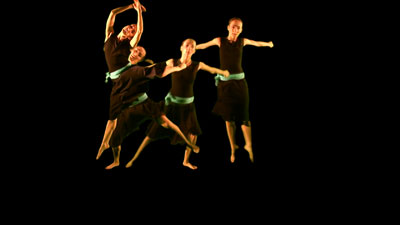
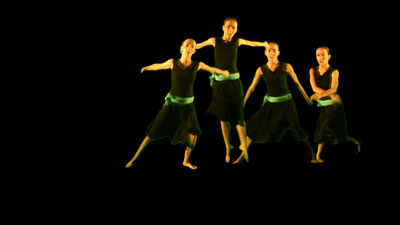
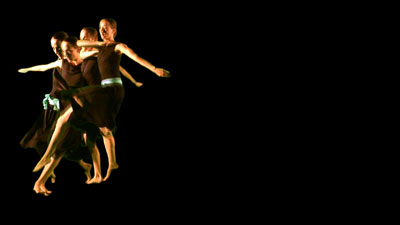
These images are from some Green Screen experiments I've been doing with a pair of Dancers in Moseley, Birmingham. I've been taking classes with them every morning and they work together professionally. This means that directing the for the filming was joy. Unfortunately I haven't got the lighting quite right yet so they get a green inner glow. I am working with Steve from FilmCafe who is a master of all things lens based. I'll put a Youtube version up soon.
Monday, November 06, 2006
My Live Feed Adventure
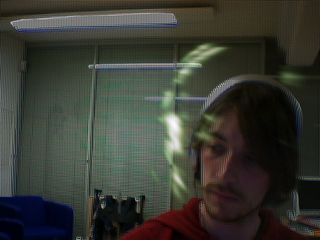
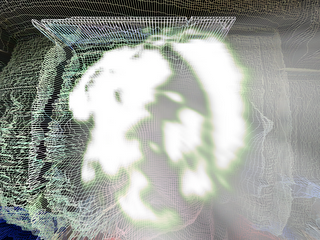
These images are stills form my a piece myself and Jonathon Green are creating for a workshop at the Ikon Gallery this Friday [10th Nov. 2006]
We've been using a mashup of Modul8 and Max_msp. Basically we have a video feed from one computer on the net running image analasys through Max_msp and then sent to the next computer as a udp stream. This is then picked up on the other computer in a Max patch and transformed into a midi stream. This is then used to control the Modul8 VJ program with live feeds from the video analysis form the other computer.

